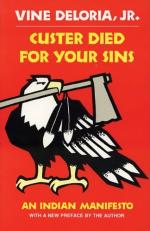
|
| Name: _________________________ | Period: ___________________ |
This test consists of 5 multiple choice questions, 5 short answer questions, and 10 short essay questions.
Multiple Choice Questions
1. What is one of the main beliefs of the Indians about their religion?
(a) That religion must be done in a group.
(b) That religious ceremonies are important and should be done daily.
(c) There is no distinciton made between religion and life's other activities.
(d) It holds a separate place in Indian society and the lines are never crossed.
2. What does the author believe the Indians should have a right to, just like water districts, cities, and towns?
(a) Citizenship.
(b) Sovereignty.
(c) Voting rights.
(d) Social services.
3. Where did Billy Mills grow up?
(a) Pine Ridge, South Dakota.
(b) Enid, Oklahoma.
(c) Sioux City, South Dakota.
(d) Topeka, Kansas.
4. As far as race relations were concerned, how were Indians classified?
(a) As Negros.
(b) As non-whites.
(c) As redmen.
(d) As white.
5. In 1964, what percentage of Indians thought the United States should get out of Vietnam?
(a) 10 percent.
(b) 15 percent.
(c) 80 percent.
(d) 85 percent.
Short Answer Questions
1. What did the office of the Bureau of Indian Affairs in Albuquerque, New Mexico do to the Tigua of El Paso?
2. What is the Aberdeen office of the Bureau of Indian Affairs known for?
3. What did the Supreme Court do in June of 1968?
4. What is the most popular and enduring subject of Indian humor?
5. Among the Sioux in the Dakotas, what was the Sun Dance reinterpreted as?
Short Essay Questions
1. What does the Indian religion require of its followers that is so vastly different from Christian religions?
2. How does white culture destroy other cultures?
3. What does the author think about the Republican political party?
4. What was the first program offered by the African Americans after the Civil War and what happened to that program?
5. What happened when the government decided to move the Bureau of Indian Affairs to Health, Education and Welfare?
6. What did missionaries do to the Indian's religious life when they arrived on the reservations?
7. According to Indian history, when did the reservation system really begin to improve and what happened when it did?
8. Why have the Indians never been involved with the Civil Rights movement?
9. Why does the joke about Falling Rocks bridge the racial gap?
10. How is teasing used as a teaching tool for Indians and how can it be used as a parenting tool?
|
This section contains 904 words (approx. 4 pages at 300 words per page) |

|




